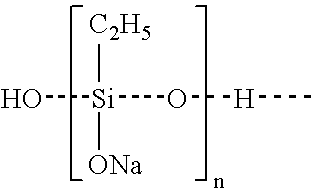Method of preventing or reducing aluminosilicate scale in high level nuclear wastes
- Summary
- Abstract
- Description
- Claims
- Application Information
AI Technical Summary
Benefits of technology
Problems solved by technology
Method used
Image
Examples
example 1
[0045] Preparation of the reaction product of SMA with butylamine and (3-aminopropyl)triethoxysilane to give a polymer with 1 mole % silane containing monomer units (Polymer i) is as follows: 10.0 g of dry SMA, with a mole ratio of styrene to maleic anhydride of about 1.0 and Mw about 16,000, is suspended in 100 ml of toluene. A solution of 1.72 g of butylamine and 0.21 g of (3-aminopropyl)triethoxysilane in 10 ml of toluene is added at ambient temperature. The mixture is refluxed for 3 hr. The solid product is filtered off, washed, and dried. This gives a polymer containing 53 mole % styrene, 23.9 mole % N-butyl half amide from maleic anhydride, 1 mole % N-(3-triethoxysilyl)propyl half amide from maleic anhydride, and 22.1 mole % maleic anhydride.
example 2
[0046] Preparation of the reaction product of SMA with butylamine and (3-aminopropyl)triethoxysilane to give a polymer with 3.8 mole % silane containing monomer units (Polymer ii) is as follows: 10.0 g of dry SMA, with a mole ratio of styrene to maleic anhydride of about 1.1 and Mw about 16,000, is suspended in 100 ml of toluene. A solution of 1.72 g of butylamine and 0.83 g of (3-aminopropyl)triethoxysilane in 10 ml of toluene is added at ambient temperature. The mixture is refluxed for 3 hr. The solid product is filtered off, washed, and dried. This gives a polymer containing 53 mole % styrene, 23.9 mole % N-butyl half amide from maleic anhydride, 3.8 mole % N-(3-triethoxysilyl)propyl half amide from maleic anhydride, and 19.3 mole % maleic anhydride.
example 3
[0047] Preparation of the reaction product of SMA with butylamine and (3-aminopropyl)triethoxysilane to give a polymer with 7.6 mole % silane containing monomer units (Polymer iii) is as follows: 10.0 g of dry SMA, with a mole ratio of styrene to maleic anhydride of about 1.1 and Mw about 16,000, is suspended in 100 ml of toluene. A solution of 1.72 g of butylamine and 1.66 g of (3-aminopropyl)triethoxysilane in 10 ml of toluene is added at ambient temperature. The mixture is refluxed for 3 hr. The solid product is filtered off, washed, and dried. This gives a polymer containing 53 mole % styrene, 23.9 mole % N-butyl half amide from maleic anhydride, 7.6 mole % N-(3-triethoxysilyl)propyl half amide from maleic anhydride, and 15.5 mole % maleic anhydride.
PUM
 Login to View More
Login to View More Abstract
Description
Claims
Application Information
 Login to View More
Login to View More - R&D
- Intellectual Property
- Life Sciences
- Materials
- Tech Scout
- Unparalleled Data Quality
- Higher Quality Content
- 60% Fewer Hallucinations
Browse by: Latest US Patents, China's latest patents, Technical Efficacy Thesaurus, Application Domain, Technology Topic, Popular Technical Reports.
© 2025 PatSnap. All rights reserved.Legal|Privacy policy|Modern Slavery Act Transparency Statement|Sitemap|About US| Contact US: help@patsnap.com



